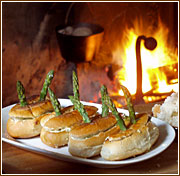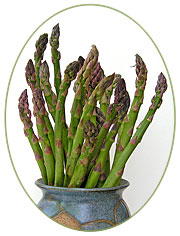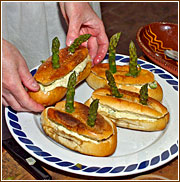STALKING THE 18TH-CENTURY ASPARAGUS
And Cooking it in an Open-Hearth

By Sandy Levins ...| ...June 14, 2005

CAMDEN, N.J. -- Although it is only one of the items routinely prepared by the open-hearth cook at Pomona Hall, "Forced Asparagus" says as much about 18th-century cooking as it does about the Delaware Valley history of the delicious vegetable itself.

|
| Photo: Hoag Levins |
Forced Asparagus as made by Hazel Werner in the open-hearth kitchen of Pomona Hall, the restored 18th-century mansion maintained by the Camden County Historical Society. Click for larger view.
|
Pomona Hall -- the 18th-century mansion maintained by the Camden County Historical Society in the Parkside section of Camden -- frequently offers open-hearth demonstrations at which cook Hazel Werner prepares traditional dishes in the traditional manner. The kitchen hearth, large enough for several people to stand in, is stoked with blazing oak and worked with ponderously heavy iron implements, just as when Marmaduke Cooper and family lived in the house in the 1780s.
Camden's Cooper family
In fact, Asparagus has been cooked in this same kitchen in the same way for well over two centuries. The early Cooper family, the clan that founded what became the City of Camden, grew the crop along with many of the area's other 18th-century farmers.
At Cooper's Point on the nearby Delaware River, Joseph Cooper wrote a paper about the plant that was presented to the Philadelphia Society for the Promotion of Agriculture in 1799. "The seed of our asparagus was procured from New York, in the year 1752," he wrote, "and since that time, I have not planted a seed, except what grew on my beds; and by selecting the seed, from the largest stalks, I have improved it greatly."
Once thought of as one of the first harbingers of spring, asparagus has

|
| Photo: Hoag Levins |
Asparagus was a major farm crop throughout the Delaware Valley during the late 1700s. Click for larger view.
| been cultivated for many centuries, although not always called by that name. Having appeared in England as early as the year 1000, it was known as sperage and sperach. Once herbalists brought the Latin name, Asparagus officinalis, into use in the 16th century, it wasn't long before common usage corrupted the name to sparagus and, by the 18th century, sparrow-grass.
Thomas Jefferson
Asparagus was grown at Thomas Jefferson's Monticello and in 18th-century Williamsburg. Extensive instructions for its planting and cultivation were documented by renowned Philadelphia nurseryman Bernard McMahon in his American Gardener's Calendar, first published in 1806. Swedish explorer Peter Kalm wrote of seeing wild asparagus growing in fields of loose soil near fences throughout New Jersey during his travels in the 18th century. And Benjamin Franklin's Pennsylvania Gazette advertised no fewer than 45 Delaware Valley plantations for sale between 1728 and 1800 -- each of which boasted large asparagus beds.
The following recipe is the one used by Pomona Hall's Ms. Werner for her own "Forced Asparagus." It is a modern interpretation from the collection of Hannah Glasse, the most influential cookbook author of the 18th century. Among Mrs. Glasse's fans were George Washington and Jefferson, both of whom owned a copy of her book, The Art of Cookery, first published in London in 1747.
Mrs. Glasse believed all things green should have crispness and that "over-boiling took away the sweetness and the beauty" of vegetables. In this recipe for "Asparagus Forced in French Rolls," the word "forced" actually means stuffed.

|
| Photo: Hoag Levins |
'Asparagus Forced in French Rolls' is a recipe that was routinely cooked in the Camden area two centuries ago. Click for larger view.
|
Asparagus Forced in French Rolls
30 fresh, thin asparagus spears
4 Tablespoons butter - no substitutions
6 small French rolls
6 egg yolks, beaten
1 pint light cream
1/2 teaspoon ground nutmeg
Salt to taste
Take six small French rolls and cut off the top crusts, making sure to keep each top crust with its matching roll. Remove the inside crumbs from each roll. In each of the six top crusts, carefully make three holes. Melt the 4 T. butter in a heavy frying pan and brown the rolls on all sides.
Meanwhile, rinse asparagus and trim off tough portions of stalks. Cover and simmer in salted water for 7-9 minutes, or until asparagus is tender but not overdone. Remove from heat and drain. Cut the tops of 18 asparagus spears to about 3" in length and reserve. Take what's left of those 18 spears, plus the rest you've cooked, and cut into 1" pieces.
In a saucepan, combine the light cream, egg yolks, a little salt and the nutmeg, and stir over medium heat until the mixture begins to thicken and comes just to a boil. Add the 1" cut pieces of asparagus to the mixture and stir well. Remove saucepan from the heat.
Like it's growing
Fill the cavity of each roll with the above mixture. Then, using the 3" tops of the asparagus spears you've reserved, place one asparagus spear in each of the three holes you've made in the tops of the French rolls. Replace each top crust on its matching roll. The asparagus should look like it's growing from the top. Serve hot. Makes six servings as a pretty side dish to be served with a main course.
~ ~ ~
Sandy Levins is a Trustee and director of programming at the Camden County Historical Society.
~ ~ ~
| 








